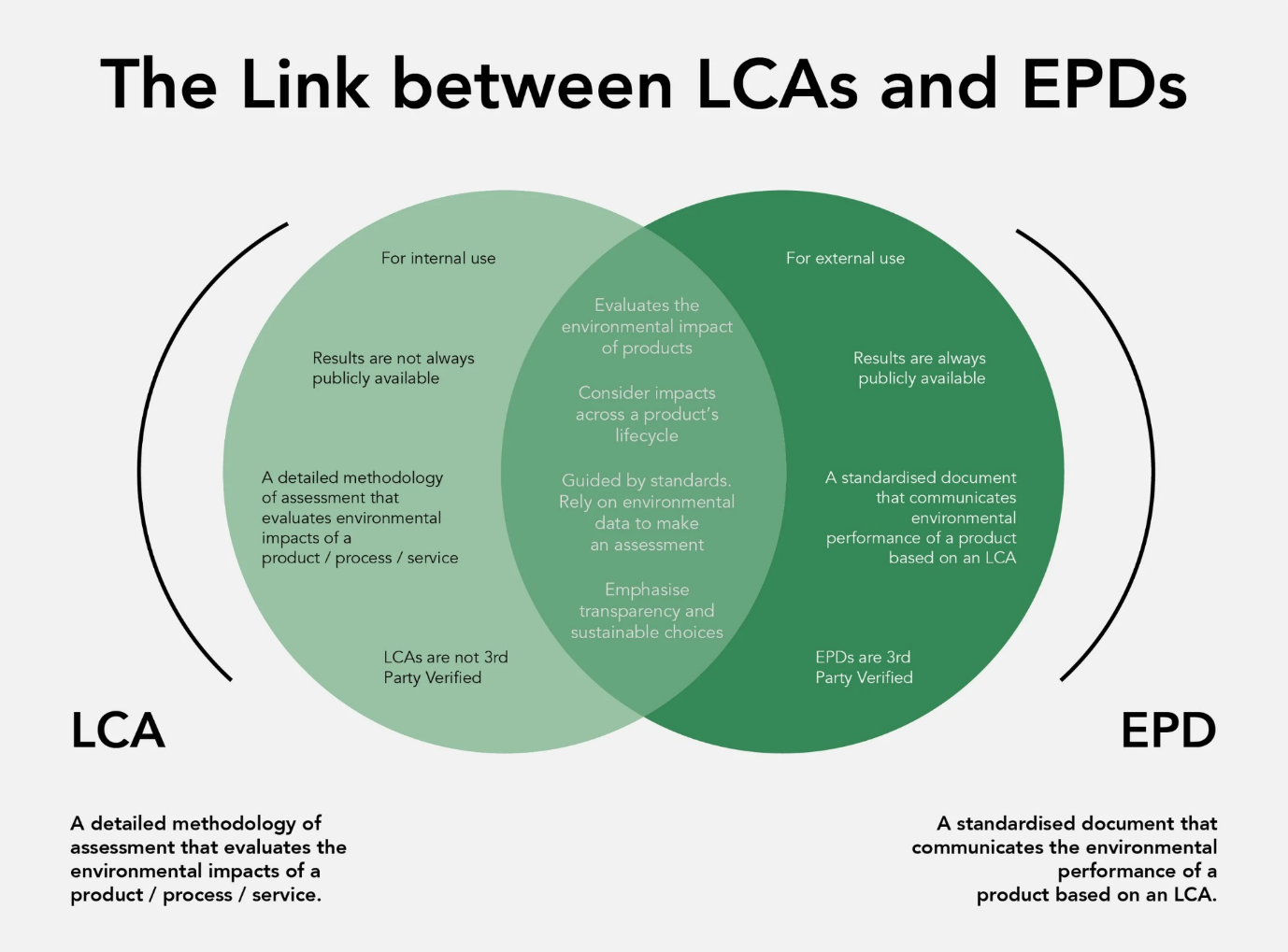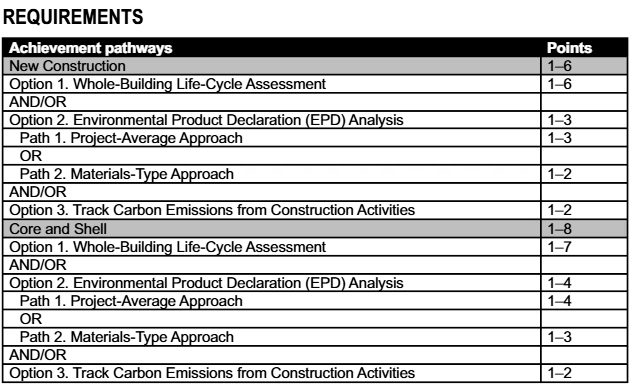
Share:
In today’s global context of increasing focus on sustainability, transparency in data has become a critical requirement in the construction industry. Two prominent tools that address this need are LCA (Life Cycle Assessment) and EPD (Environmental Product Declaration). Beyond helping projects earn credits in green building certification systems such as LEED or BREEAM, LCA and EPD are also long-term strategies to enhance credibility and value for projects.

LCA and EPD: Scientific Evidence for Transparency in Green Certifications
In today’s global context of increasing focus on sustainability, transparency in data has become a critical requirement in the construction industry. Two prominent tools that address this need are LCA (Life Cycle Assessment) and EPD (Environmental Product Declaration). Beyond helping projects earn credits in green building certification systems such as LEED or BREEAM, LCA and EPD are also long-term strategies to enhance credibility and value for projects.
What are LCA and EPD?

-
LCA (Life Cycle Assessment): A scientific methodology for analyzing and quantifying the environmental impact of a product or building throughout its entire life cycle—from raw material extraction, production, transportation, use, to end-of-life treatment.

- EPD (Environmental Product Declaration): A transparent, ISO 14025–based document that provides measurable indicators such as GWP (Global Warming Potential), ODP (Ozone Depletion Potential), AP (Acidification Potential), POCP (Photochemical Ozone Creation Potential), etc. It serves as a standardized dataset that allows stakeholders to easily evaluate and compare the environmental impact of building materials.

LCA and EPD in LEED
In LEED v5, LCA and EPD are directly integrated into the Materials & Resources category:

- LCA: Projects can earn 1–7 points depending on the reduction in carbon emissions (GWP) compared to industry benchmarks.
- EPD: mang lại 1–3 điểm khi chủ đầu tư lựa chọn sử dụng các sản phẩm có chứng chỉ EPD, với 2 cách tiếp cận: trung bình toàn dự án hoặc theo từng loại vật liệu.

This shows that LEED views material transparency as reliable evidence to encourage sustainable design.
LCA and EPD in BREEAM
Unlike LEED, BREEAM does not award direct credits for EPDs, but considers them as standardized data sources to justify sustainable material choices. LCA tools are recommended in BREEAM to assess building life cycles, thereby improving scores in categories such as:
-
Mat 01: Life Cycle Impacts
-
Mat 02: Environmental Product Declarations
-
Mat 06: Material Efficiency
Conclusion
In the shift towards sustainable construction, LCA and EPD have become the “data gatekeepers” that enable projects not only to achieve points in LEED or BREEAM, but also to elevate their international market position. Data transparency is the foundation for turning challenges into opportunities, creating truly green buildings, and affirming a long-term sustainability strategy.
Frequently Asked Questions
Q1: Under LEED v5, how mandatory is Life-Cycle Emissions assessment (including Embodied Carbon) for New Construction projects?
A1: In LEED v5, all New Construction projects are required to complete the Carbon Assessment Prerequisite, which includes estimating both operational and embodied carbon from the design stage. This makes LCA a fundamental element of certification.
Q2: In LEED v5, for the credit “Reduce Embodied Carbon,” which materials are emphasized by USGBC for priority carbon reduction, and why?
A2: LEED v5 identifies high-carbon materials such as concrete, steel, aluminum, and other cast industrial products as critical “hotspots.” These materials typically have large embodied carbon footprints due to energy-intensive production and transportation. Reducing emissions in these categories has the most significant impact on a project’s overall embodied carbon.
Q3: In GRESB Real Estate Standard 2025, under which section is asset-level GHG data reporting required, and how can LCA support this?
A3: In GRESB 2025, the Performance Component requires asset-level reporting on GHG emissions, energy, and building performance indicators. LCA provides embodied carbon data (part of GHG Scope 3) for assets. If EPDs or life-cycle product reports are available, they can be incorporated into GHG reporting for a more comprehensive submission.
Q4: When using EPDs in LEED, how many product EPDs and from how many manufacturers are required to earn credits under “Building Product Disclosure & Optimization – EPDs”?
A4: In LEED v4/v4.1, the requirement is at least 20 different products from 5 or more manufacturers with valid EPDs. Product-specific EPDs (Type III – ISO-compliant) are given greater weight.
Q5: Does GRESB treat EPDs as mandatory indicators for scoring, or as supporting information?
A5: Currently, GRESB does not treat EPDs as mandatory indicators for scoring. Instead, EPDs are considered supporting tools for embodied carbon and Scope 3 GHG reporting, ESG transparency, and improving the reliability of submissions. GRESB Reference Guides recommend standardized, verified datasets (including LCA and EPDs) to enhance data quality and effectiveness.
Thus, EPDs serve as a “common language” for projects to reference and demonstrate reductions in environmental impact.
Strategic Value: From Compliance to Competitive Advantage
Applying LCA and EPD goes beyond technical compliance for green certifications. It also represents:
Scientific and transparent evidence: Provides verifiable, quantitative data that eliminates doubts about “greenwashing.”
Brand credibility: Demonstrates environmental responsibility, creating differentiation for investors, clients, and the community.
ESG management tools: Supports ESG reporting and sustainable development with reliable data, easily integrated into frameworks such as GRI, SASB, TCFD.
Attraction of green finance: Many international funds and banks prioritize projects with proven emission reductions and transparent life cycle data.
Compliance with new policies and regulations: Positions projects ahead of tightening requirements from governments and markets (e.g., EU Green Deal, Carbon Border Adjustment Mechanism).
Competitive edge in international tenders: Increasingly, major investors and contractors require EPDs as mandatory for project participation.
Life-cycle cost optimization: Through LCA, projects can identify solutions to reduce operational, maintenance, and end-of-life costs.
Asset value enhancement: Buildings with transparent environmental data often achieve higher resale and rental values due to greater investor and client trust.
Latest news
Special Highlights of COP30: When the World Looks to the Amazon for Climate Action of the Future
COP30 marks the 30th Conference of the Parties to the UNFCCC (United Nations Framework Convention on Climate Change).
Criticality Assessment: The First Step Toward Building Resilience
Europe is entering a major transformation in resilience thinking. Under the Critical Entities Resilience (CER) Directive, organizations are not only required to manage risks but also to understand, demonstrate, and maintain the elements that are “critical” to their operations, economy, and society.
Carbon Trading Systems and the Reshaping of the Construction Industry’s Future
The construction industry is one of the largest sources of greenhouse gas emissions, accounting for around 37% of total global CO₂ emissions (IEA, 2022). The expansion of Emissions Trading Systems (ETS) beyond the energy sector into carbon-intensive industries — including building materials and operational processes — is reshaping the entire cost structure and competitive strategies of the construction sector.
Green Finance in Real Estate: Investment Opportunities and Strategies for Developers in Emerging Markets
The global real estate sector is both the largest source of emissions and the greatest investment opportunity in the journey toward net-zero. According to IFC (2025), greening the construction value chain could unlock USD 1.5 trillion in investment opportunities across emerging markets in the next decade.
ARDOR Green is recruiting the next generation of sustainable architects/engineers at the Bach Khoa Career Fair
Founded in 2005, ARDOR Architects has over 20 years of experience in architectural and urban planning consultancy, with participation in more than 150 projects and numerous international awards such as Top 10 Architects Ashui (2017) and BCI Asia Awards (2009, 2015, 2021).
From Commitment to Implementation of ESG in Vietnamese Enterprises
In today’s global context, ESG (Environmental – Social – Governance) is becoming a “new passport” for businesses. It is not only a factor that international investors and partners consider when cooperating, but also a competitive standard within global supply chains.
Build Green, Build with ARDOR Green







